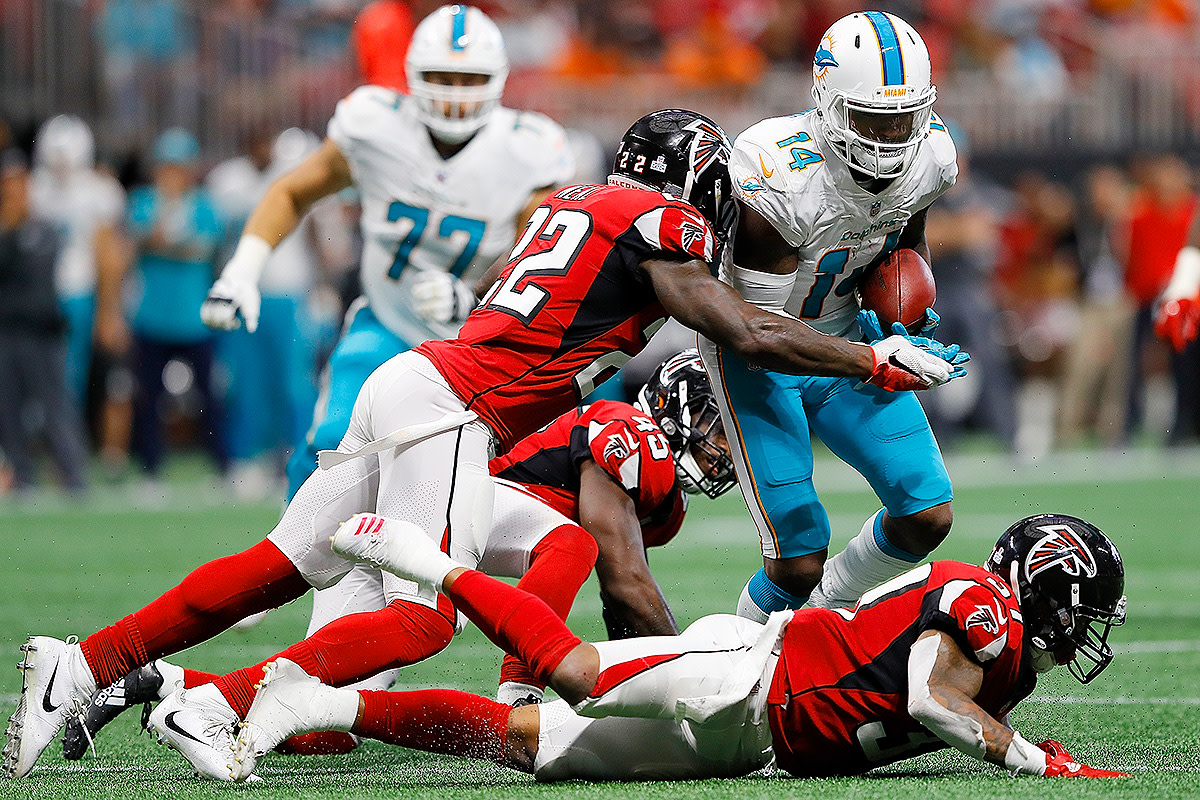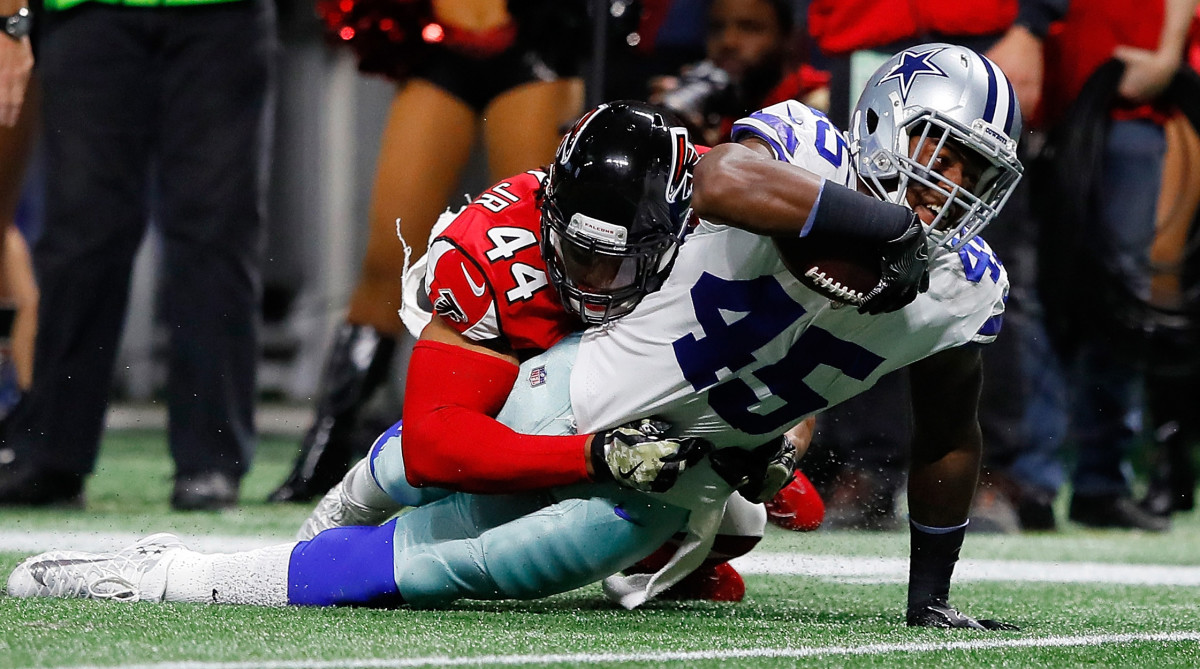The Importance of the Roll Tackle, as Explained—and Demonstrated—by Dan Quinn

Suddenly I’m lying on the carpet of a ballroom at The Conrad, a hotel in downtown Indianapolis. The man who put me there, Falcons head coach Dan Quinn, is also on the ground.
“You see?! You see how it works?” Quinn says, springing to his feet. “That’s the ‘roll tackle.’”
Slowly picking myself up, I stammer a short-breathed affirmative and nod several times, hoping that’s enough to suggest that I fully understand the concept and that there’s no need to demonstrate it again. I badly want to look down and see if my jeans—my GOOD jeans—are ripped, but with Quinn eying me, I can’t do that without revealing the full extent of my wimpiness. (My jeans were fine, of course.)
Quinn is giving me a formal tackling lesson as part of our annual football conversation at the NFL combine. I realized Quinn’s enthusiasm when, for this instructive session, he started moving ballroom chairs that were already out of the way. We had about a 2,000 square-foot playing area—plenty of room to move at a faster-than-walking clip. However there was no mention of a live tackling demonstration until about three seconds before he performed one. Three seconds, I found, is just enough time for fear to swell up, but somehow not enough time to think and say, “Hey, wait!”
It’s important to know that this tackle—the roll tackle—involved grabbing and spinning my legs, but not initially contacting their lower parts. Roll tackles are what you employ when trying to bring down quick, shifty runners. You hit, lift and roll, wrapping the player’s legs and rolling to the ground.
“I don’t like hits out of the strike zone,” Quinn had said when we started, his tone conveying no room for negotiation. “Hits to the head and hits below the thigh, I don’t like them.” It’s for players’ safety, certainly, but also for their technique. And THAT’S what Quinn wants to relay—that the safest way to tackle is also the best way.
Typically, my combine talks with Quinn are off the record. But this one, he wanted ON the record. Quinn wants others, inside and outside of football, to understand tackling—the purest part of the game and backbone of Atlanta’s scheme. The Falcons are a rally-and-hit defense, and they’ve installed distinct methods of employing those rallies and hits.

After explaining the strike zone, Quinn talked about its epicenter: the ballcarrier’s near hip. The near hip is the runner’s hip that’s nearest to you, the defender. You get low, sprint and hit that hip with your related shoulder, meaning left shoulder on left hip, right shoulder on right hip. It’s important not to become a one-shoulder-dominant tackler. Players sometimes develop the bad habit of incorrectly leading with the shoulder that’s above their dominant hand. Another thing they might do is cross a ballcarrier’s face upon reaching him. That compromises your leverage and puts your head in the equation. Upon contact with your shoulder, your head must go behind the defender. (I ask Quinn if they showed their players the Ryan Shazier injury play. “We did,” he says somberly.)
All of these principles are for tackling runners at an angle, which is how the overwhelming majority of NFL tackles are made. In fact, Quinn explains, a ballcarrier only squares up against a looming tackler if the defense has done something wrong.
“It’s all about owning your leverage. If you’re profile tackling, coming straight downhill and filling, which is usually in the A and B gaps, you need to pick a side. You never give a ballcarrier a two-way go.” The two-way goes are how many breakaway runs occur.
Which side a tackler picks for attacking a runner is dictated by the runner’s front hip, but also by the rest of the defense. You force a ballcarrier to your nearest help defender. You find your nearest help by applying the same spacing and leverage rules that you do to coverage. In the simplest terms of Atlanta’s staple Cover 3, for example, a cornerback’s most immediate nearest help is the outside linebacker/slot corner in the flat. The outside backer/slot corner’s nearest help is the inside linebacker.
As Quinn puts it, “If you treat your tackling pursuit leverage like your coverage leverage, you’ll never be wrong.” This is how defenders all know where to go when more than one of them are pursuing a tackle. Quinn calls these compression tackles—two defenders closing in, one on each side, compressing a runner.
Quinn explains all of this as we go through the motions, and to ensure that I accurately remember it, I dictate items into my phone’s voice note program. Of course, Quinn observes this with acute intensity and corrects even the tiniest of details.
The Falcons head coach doesn’t want to remove the violence from football, just the excessive danger. The hits to the strike zone are still meant to punish opponents. A defense wants that wear and tear to add up. To illustrate this, Quinn punctuates all of his technique explanations by lowering his shoulder and then bursting it forward, inches from my hip. Every time, I subtly recoil and resist the urge to yelp.
“If your hit lands up high, near their chest, then it’s wrap and drive for five,” Quinn explains as we move on from roll tackles. This is after he took me to the ground, and so I’m not surprised when Quinn engulfs me and churns his feet, taking me back towards the wall. I’m sure this wasn’t nearly as forceful as it felt—in fact, I shudder at the wryness of Quinn’s inevitable smile when he reads this—but around the third or fourth step while wrapped in Quinn’s arms, I can’t help but worry that he might forget to stop. (He remembers.)

After the live-action rounds, we put on some film, and the stuff we covered is evident on every play. On one snap, a defender fires into the backfield unimpeded but, instead of hitting and wrapping, he delivers a forearm shimmy—a horrible technique that sometimes proves too tempting for big hitters. A few snaps later, we see a defensive end reach the backfield and place his right shoulder perfectly on the running back’s right hip. Quinn beams.
“That’s the great thing about it,” he says. “By using the correct technique, he naturally executed his edge contain perfectly.” We get through a few more plays, Quinn perking up every time his players do it right. When GM Thomas Dimitroff comes over, our lesson ends. He and Quinn have a scheduled meeting.
A few days later, in a downtown Indianapolis coffeehouse, I was sitting with another NFC South coach, when Quinn approached us. “Hey Coach,” Quinn says. “Just so you know, you can tackle this guy.”
Well, sort of. But if he does, I’ll now know how to critique it.
